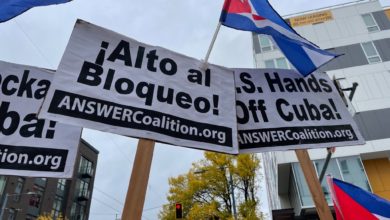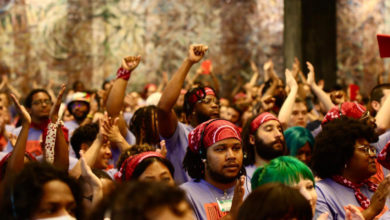 Housing is subsidized by Cuba’s government. Photo: Bill Hackwell |
To compound these problems, in October 2003, the Bush Administration announced a drastic plan to tighten the U.S. economic blockade, which has been in place since 1962. Not only did the new measures practically eliminate travel and cultural exchange, they also reduced the remittances that Cubans in the United States could send to family members in Cuba by 90 percent. The U.S. government now restricts Cuban families in the United States to one visit to Cuba every three years.
Despite the magnitude of these obstacles, the Cuban economy is moving forward. Due to cooperative agreements with Venezuela, strengthened ties with China and the discovery of oil off the northern coast, Cuban officials are now speaking of gradual economic recovery and a new stage in Cuba’s development.
The ‘Special Period’
The collapse of the socialist bloc in 1991 eliminated more than 85 percent of Cuba’s foreign trade. In the face of scarcity and a hostile world economy, the country was forced to declare a “Special Period,” in which tourism and foreign capital would play an increased role in stimulating economic activity.
Although the government continued to provide free education and health care, without its major trading partners it was unable to secure many foreign-produced goods. Most agricultural production and social services were still based on the regular peso.
To satisfy demand for additional goods, an informal, underground market grew. In this period, access to dollars and employment in the tourism industry greatly impacted one’s standard of living. The Cuban leadership explained the strategic shift toward introducing some capitalist-style reforms in order to “save the socialist gains.”
Recognizing that some inequalities would result from introducing dollars into the economy, the concessions were described to the whole population as a necessary move for economic survival. Tourism would enable the country to attract potentially millions of tourists as a new source of hard currency. With a 34.5 percent decline in the country’s production in the early 1990s, the value of Cuba’s national peso—the main currency used by the Cuban population—dropped drastically to 150 pesos for every U.S. dollar. The agricultural sector was reorganized and individual incentive was introduced through farmer’s markets, among other things.
But the Cuban government became increasingly concerned by the social differentiation that resulted from the two-tier economy over the next few years.
In 1994, the Cuban government established the convertible peso, a second Cuban currency that was pegged 1:1 to the dollar. This move represented Cuba’s institutionalization of the currency problem. In the short term, it accepted the power of the dollar with the long-term goal of “de-dollarizing” and, ultimately, returning to a unified Cuban peso.
Capitalist governments in the underdeveloped world often celebrate the “dollarization” of their economies. To them, it represents induction into the world economic order. Cuban officials, on the other hand, recognized the long-term structural contradictions caused by introducing dollars into the planned economy, and described the economic adjustments as temporary, but necessary, retreats.
Although the Cuban government stepped up its partnerships with foreign capitalist enterprises, the agreements always stipulated governmental control and majority ownership. Cuba rejected western neoliberalism, whereas other countries like Argentina and Ecuador suffered long-term devastating depressions because they submitted to the economic recipes cooked up by the World Bank and International Monetary Fund.
By 1996, tourism, reorganized agriculture, foreign investment in key industries like nickel and oil exploration and other changes sparked economic growth. The downturn of the “Special Period” was reversed. The value of the national peso increased from 150 per U.S. dollar to 26 per dollar.
Cuba strengthens currencies
In the last six months, the Cuban government has proven that it can make economic advances through its alliances with Venezuela and China. Its planned economy has demonstrated the ability to weather the worldwide economic downturn.
The Cuban government is reasserting greater control over the distribution of the nation’s resources.
Last fall, the U.S. Federal Reserve began to “crack down” on foreign banks that dealt in dollars with Cuba. In May 2004, the Fed fined the largest Swiss bank, UBS AG, $100 million. The Cuban government removed the dollar from circulation in response. It also imposed a ten percent commission on all dollar exchanges. The government now centralizes the transactions of other “hard currencies” through its Central Bank.
On March 18, 2005, Cuban President Fidel Castro announced a seven percent revaluation of the regular Cuban peso relative to the dollar. One week later, he announced that the convertible peso would be pegged to the euro and other hard currencies instead of the weakening dollar. This move amounts to an eight percent of revaluation of the convertible peso—now the predominant hard currency in the country—and the near complete “de-dollarization” of the Cuban economy.
New trade partnerships
Castro pointed to the economic engines driving the Cuban economy’s growth. “A new motor named China has emerged, as well as Chavez’s Bolivarian revolution,” he said. (Associated Press, Feb. 16, 2005)
Cuba has been able to reassert its economic sovereignty largely because of its strengthened ties with Venezuela and China. In the last year, Cuba has shored up agreements with resource-rich Venezuela, the world’s fifth-leading producer of oil, and China.
In mid-December 2004, President Hugo Chavez of Venezuela visited Havana to complete a cooperative economic agreement with Cuba—the “Bolivarian Alternative for Latin America and the Caribbean” (ALBA). The agreement is an alternative to U.S. imperialism’s FTAA—Free Trade Area of the Americas—or ALCA in Spanish. Under ALBA, both countries draw on the strengths of the other. The two countries have eliminated all taxes and import duties on the other’s products.
Every day, Venezuela sends to Cuba 53,000 barrels of crude oil at preferential rates. This satisfies roughly one-third of the island nation’s oil needs. The Cuban government has committed vast human resources—particularly doctors and literacy teachers—to assist in the unfolding process of Venezuela’s Bolivarian Revolution in return.
Castro recently announced that, within 18 months, the power cuts and blackouts that characterized the “Special Period” will no longer be a feature of Cuban life. This is a result of the influx of Venezuelan oil and the facilitation of energy-efficient homes.
Over the last year, China has forged closer ties with Venezuela and has recently agreed to invest in and purchase nickel from Cuba. Nickel, used in steel production, represents a significant portion of Cuba’s economy. Cuban officials forecast the production of 77,000 tons of nickel in 2005. At the current market price, that would generate over a billion dollars.
China has also pledged to increase its involvement in tourism to Cuba, as well as its telecommunications system.
The three nations have also discussed a joint venture for the production of stainless steel in Venezuela. In the agreement, a refinery in Cuba’s Cienfuegos province that was partially constructed before the overthrow of the Soviet Union would be revived and co-owned by Venezuela.
Cuba helps the most vulnerable
Throughout the difficult “Special Period,” social services remained Cuba’s top priority. It retained one of the world’s leading health care systems, 98 percent literacy and free education. Infant mortality was reduced every year to the remarkable rate of 5.8 deaths per 1,000 live births. Overall social spending actually increased over the period.
Pensions remained relatively low in the “Special Period.” The small monthly payments were still enough for the great majority of Cuban retirees who live with their families. And dining halls were opened for the most vulnerable sectors of society, such as retirees without nearby family. Every retiree has a place to live in Cuba because the government fully subsidizes housing.
With Cuba’s resurgent economy, the government now has the ability to rectify some of the inequities produced by the “Special Period.” In his Feb. 24 speech, Castro said, “We are going to collect and redistribute what we have to improve Cuban salaries.”
The Cuban government is implementing a new Social Security plan to aid pensioners. Nearly 500,000 families receiving assistance will receive an additional 50 pesos per month. All pensioners earning less than 300 pesos per month will see substantial increases. The pensioners will benefit from the increased purchasing power of the regular Cuban peso.
Cuba has seized upon the first indicator of economic success to bolster its comprehensive Social Security program—at the same time that the Bush administration aims to hand over U.S. workers’ Social Security benefits to Wall Street and rob U.S. workers of their hard-earned retirement money.
Cubans are seeing other benefits as well. Castro announced on International Women’s Day that electric rice cookers and pressure cookers would be produced en masse and made available to every household at subsidized prices. The cookers are a staple of the Cuban kitchen, but during the “Special Period” they were imported and only available in “dollar stores.” The stores were too expensive for most Cubans.
Cuba is reasserting control over the production of such essential goods. It is no longer accepting the dominance of the “private sector” in consumer goods. Referring to the reliance on the “dollar stores,” Castro said, “We hated having to do that. It created so many inequalities.”
Castro also recently announced a plan to ship 40,000 tons of rice and grain to the eastern provinces of the country, which have suffered the most from the 2004 drought. Such efforts are commonplace. In the last two years, the Cuban government has spent hundreds of millions of dollars to develop hydraulic works and industrial production in those provinces.
Cuba is not a wealthy country. Its leaders aren’t millionaires or oil tycoons. It does not possess a trillion-dollar budget or take in massive profits. The economic success that enabled these recent reforms was much humbler: Cuba simply registered a surplus for the first time in a decade.
Cuba continues to face many economic challenges, from the vicissitudes of the global capitalist market to the increased aggression of the U.S. blockade. The drought shows no sign of letting up. Of Cuba’s 235 dams and reservoirs, 114 have less than 25 percent of capacity.
But the example of what Cuba has done with relatively few resources shows the superiority of a social system that is organized to meet human needs.





